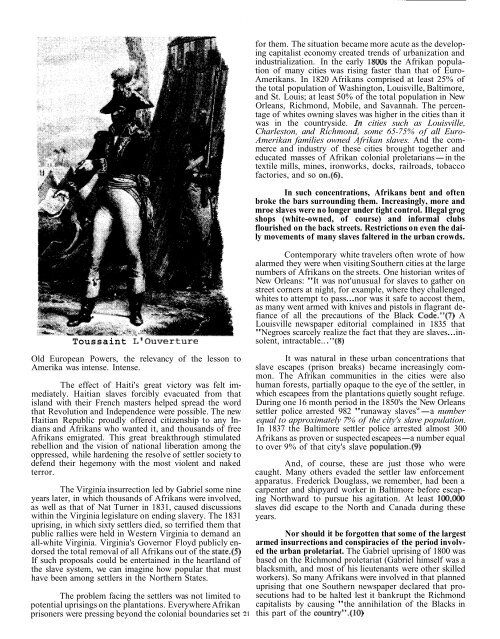sakaisettlersocr
sakaisettlersocr
sakaisettlersocr
You also want an ePaper? Increase the reach of your titles
YUMPU automatically turns print PDFs into web optimized ePapers that Google loves.
Toussaint L'Ouverture<br />
Old European Powers, the relevancy of the lesson to<br />
Amerika was intense. Intense.<br />
The effect of Haiti's great victory was felt immediately.<br />
Haitian slaves forcibly evacuated from that<br />
island with their French masters helped spread the word<br />
that Revolution and Independence were possible. The new<br />
Haitian Republic proudly offered citizenship to any Indians<br />
and Afrikans who wanted it, and thousands of free<br />
Afrikans emigrated. This great breakthrough stimulated<br />
rebellion and the vision of national liberation among the<br />
oppressed, while hardening the resolve of settler society to<br />
defend their hegemony with the most violent and naked<br />
terror.<br />
The Virginia insurrection led by Gabriel some nine<br />
years later, in which thousands of Afrikans were involved,<br />
as well as that of Nat Turner in 1831, caused discussions<br />
within the Virginia legislature on ending slavery. The 183 1<br />
uprising, in which sixty settlers died, so terrified them that<br />
public rallies were held in Western Virginia to demand an<br />
all-white Virginia. Virginia's Governor Floyd publicly endorsed<br />
the total removal of all Afrikans out of the state.@)<br />
If such proposals could be entertained in the heartland of<br />
the slave system, we can imagine how popular that must<br />
have been among settlers in the Northern States.<br />
The problem facing the settlers was not limited to<br />
potential uprisings on the plantations. Everywhere Afrikan<br />
prisoners were pressing beyond the colonial boundaries set 21<br />
for them. The situation became more acute as the developing<br />
capitalist economy created trends of urbanization and<br />
industrialization. In the early 1800s the Afrikan population<br />
of many cities was rising faster than that of Euro-<br />
Amerikans. In 1820 Afrikans comprised at least 25% of<br />
the total population of Washington, Louisville, Baltimore,<br />
and St. Louis; at least 50% of the total population in New<br />
Orleans, Richmond, Mobile, and Savannah. The percentage<br />
of whites owning slaves was higher in the cities than it<br />
was in the countryside. In cities such as Louisville,<br />
Charleston, and Richmond, some 65-75% of all Euro-<br />
Amerikan families owned Afrikan slaves. And the commerce<br />
and industry of these cities brought together and<br />
educated masses of Afrikan colonial proletarians-in the<br />
textile mills, mines, ironworks, docks, railroads, tobacco<br />
factories, and so on.(6).<br />
In such concentrations, Afrikans bent and often<br />
broke the bars surrounding them. Increasingly, more and<br />
mroe slaves were no longer under tight control. Illegal grog<br />
shops (white-owned, of course) and informal clubs<br />
flourished on the back streets. Restrictions on even the daily<br />
movements of many slaves faltered in the urban crowds.<br />
Contemporary white travelers often wrote of how<br />
alarmed they were when visiting Southern cities at the large<br />
numbers of Afrikans on the streets. One historian writes of<br />
New Orleans: "It was not'unusual for slaves to gather on<br />
street corners at night, for example, where they challenged<br />
whites to attempt to pass ... nor was it safe to accost them,<br />
as many went armed with knives and pistols in flagrant defiance<br />
of all the precautions of the Black Code."(7) A<br />
Louisville newspaper editorial complained in 1835 that<br />
"Negroes scarcely realize the fact that they are slaves ... insolent,<br />
intractable.. . "(8)<br />
It was natural in these urban concentrations that<br />
slave escapes (prison breaks) became increasingly common.<br />
The Afrikan communities in the cities were also<br />
human forests, partially opaque to the eye of the settler, in<br />
which escapees from the plantations quietly sought refuge.<br />
During one 16 month period in the 1850's the New Orleans<br />
settler police arrested 982 "runaway slaves w -a number<br />
equal to approximately 7% of the city's slave population.<br />
In 1837 the Baltimore settler police arrested almost 300<br />
Afrikans as proven or suspected escapees-a number equal<br />
to over 9% of that city's slave population.(9)<br />
And, of course, these are just those who were<br />
caught. Many others evaded the settler law enforcement<br />
apparatus. Frederick Douglass, we remember, had been a<br />
carpenter and shipyard worker in Baltimore before escaping<br />
Northward to pursue his agitation. At least 100,000<br />
slaves did escape to the North and Canada during these<br />
years.<br />
Nor should it be forgotten that some of the largest<br />
armed insurrections and conspiracies of the period involved<br />
the urban proletariat. The Gabriel uprising of 1800 was<br />
based on the Richmond proletariat (Gabriel himself was a<br />
blacksmith, and most of his lieutenants were other skilled<br />
workers). So many Afrikans were involved in that planned<br />
uprising that one Southern newspaper declared that prosecutions<br />
had to be halted lest it bankrupt the Richmond<br />
capitalists by causing "the annihilation of the Blacks in<br />
this part of the country".(lO)


